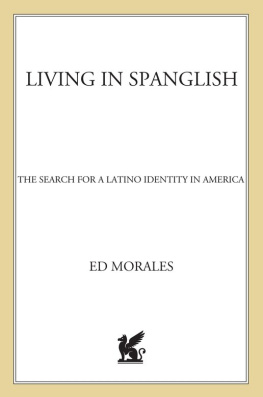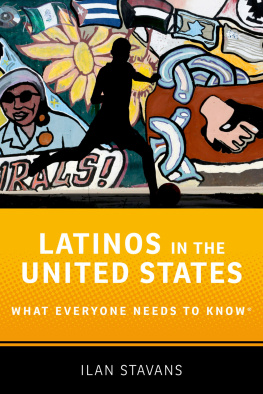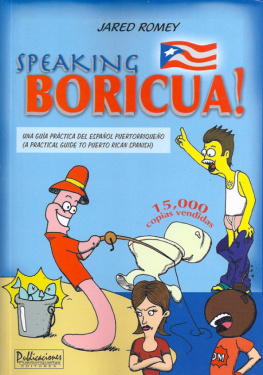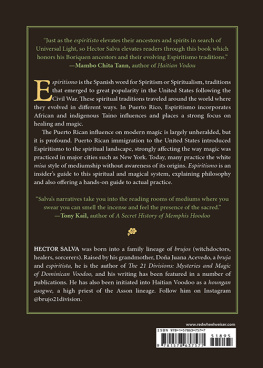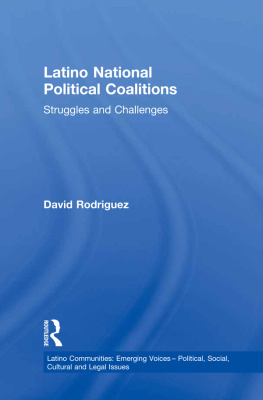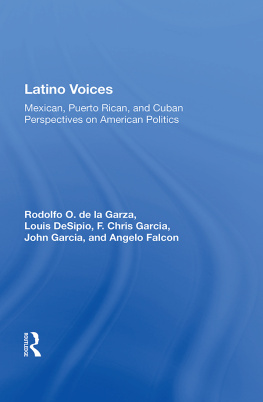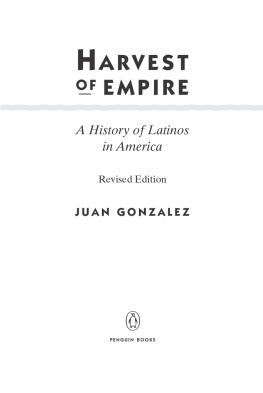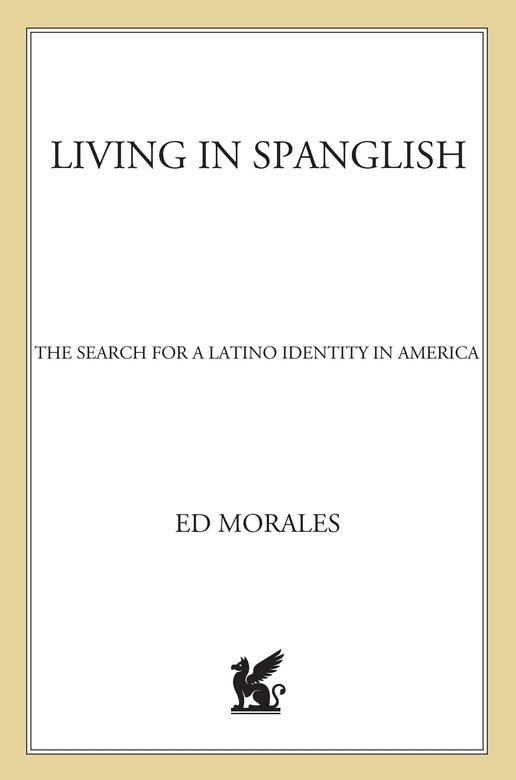This book is a product of my journalistic and creative work over the last fifteen years, and reflects all the people and places I came into contact with during those endeavors. There are too many moments and feelings and colors and instances of humanity for me to acknowledge, but here are a few:
I wish to thank my parents, Zoilo and Maria Morales, for possessing the courage to come to New York from Puerto Rico as very young adults and making sure I would feel at home here. My loved one, Adriana Lpez, for helping me see the intense passion and ecstatic contradictions of our Spanglish blood, and for never giving up on me. My sister, Marisa, and her husband, Rolando Briceno, and Adrianas parents, Victoria Vargas and Pedronel Lpez.
For the conception and execution of Living in Spanglish , I would like to thank my agent, Daniel Mandel, who helped me make sense of a tangled mass of ideas floating in my head several years ago. I thank also Elizabeth Beier, my editor, for keeping me honest and focused, her assistant, Michael Connor, and Dana Albarella, my original editor at St. Martins, who first took a chance on the idea. I give it up to compaero Felix Rivera in the SMP publicity department. Thanks also to Susan Bergholz, whose faith in my ability was crucial to what eventually bore fruit in this book.
Thanks to all my colleagues in the world of journalism: Gershon Borrero, Joie Davidow, Mandalit Del Barco, Julian Dibbell, Karen Durbin, Enrique Fernandez, Luis Francia, Annette Fuentes,Richard Goldstein, Sandra Guzman, Maria Hinojosa, Lisa Jones, Andrea Kannapell, Dennis Lim, Evelyn McDonnell, Abby McGanny-Nolan, Evette Porter, Elaine Rivera, Rosana Rosado, Karen Rothmyer, Danyel Smith, Greg Tate, Peter Watrous, and the late Ross Wetzsteon.
Thanks to all the Nuyorican people I lived the life of an underground poetry star with: Miguel Algarn, Paul Beatty, Dana Bryant, Steve Cannon, Willie Correa, Julio Dalmar, Maggie Estep, Reg E. Gaines, Lois Elaine Griffith, Bob Holman, Tracie Morris, Dael Orlandersmith, Willie Perdomo, Pedro Pietri, Edwin Torres, and Mike Tyler.
Thanks to the encouragement and support of friends: Yuzzy Acosta, the late Ana Araiz, Ivan Benavides, Hector Buitrago, Jeff Chaffa, Julio Correal, Esperanza Cortes, Angie Cruz, Andrea Echeverri, Erica Gonzalez, Sonia Gonzalez, Michelle Habell-Pallan, Jaime Cardenas, Lalo Lpez Alcaraz, Angelo Falcon, Richard Gans, Saul Hernndez, Darius James, Paul Kachur, Phillip and Lilah Levin, Marta Lucia, Marc Nirenberg, German Prez, Richard Prez, Michael Pribich, Marusa Reyes, Alexandra Rosa, Abel Salas, Rodrigo and Luz Maria Salazar, Ray Santisteban, the Women of WILL, Fernando Zapata, and so many others.
Finally, two teachers, David Gordon and David Zilberman, and a visionary, Eddie Figueroa, whose souls have passed into eternity.
THE ROOTS OF SPANGLISH
The Pachuco does not wish to return to his Mexican origin, nor it would seem does he wish to blend into North American life.
OCTAVIO PAZ , The Labyrinth of Solitude
Puerto Rico, 1974
This is not the place where I was born.
MIGUEL PIERO
Greater East Los Angeles, February 20, 6:30 P.M.
Home away from home away from home.
LUIS VALDEZ
To be Spanglish is to live in multisubjectivity; that is, in a space where race is indeterminate, and where class is slipperier than ever. As an integral part of their history, Latin Americans engaged in a mass experiment in racial miscegenation. Social class was partially determined by relative skin tone, although family standing, the ability to trace lineage to Spain, and, of course, accumulated wealth were important factors. But the economic instability of Latin America made social class lines fluctuate wildly, and it didnttake much for a familys standing to slip rapidly over a brief period of time. When Latinos came to North America, some were able to transfer their class standing into American categories. But the majority of us came into the lower portions of the labor pool, bringing with us a fluid sense of race and class, and we began to immediately create a new multisubjective sense of ourselves, which could be thought of as Spanglish.
Who are the Spanglish people and when did they appear? Legends of the conquest of Mexico point to La Malinche, a woman from the Maya nation that extended from Yucatan to Guatemala, who journeyed with the conquering Corts into the heart of the Aztec empire as his translator. La Malinche, a.k.a. Doa Marina, served as an interface between Europe and the Americans, and has taken on all manner of criticism for selling out her own people and aiding the Spanish conquest of Tenochtitlan, the seat of Aztec power. She was said to have borne a child to Corts, the first mestizo child of the Americas. Malinches betrayal was real, yet inevitable. Her actions dont constitute an utter betrayal of Mexicos indigenous people, since there were several tribes to the south and east of Tenochtitlan that joined Cortss army merely because of rivalry with Moctezumas clique. But La Malinche set off a chain reaction of race-mixing that gave birth to the encroaching Spanglish reality of the twenty-first century, and it is most fitting that she accomplished this at the intersection of two languages, two cultures. In order to survive, she took on both, became both. That capacity, in a nutshell, is what Spanglish is all about.
To become Spanglish is to fuse the North American with the Latin American in a way that approaches the former with a healthy skepticism and takes care not to obliterate the essence of the latter. It is a sometimes violent, sometimes delicate rethreading of two parallel story lines, of long-separated siblings and hated enemies. Becoming Spanglish is inextricably linked with history and issues of race and class, and there are two tendencies that I consider central to understanding the process.
First, the great majority of migrants and immigrants from LatinAmerica to North America came from the lower classes, and tended to be of darker skin tone than the elites of their origin countries. Second, their class standing tended to be fixed in Latin America and seemed to have more potential to change in North America, while their racial oppression, which was more subliminal in Latin America, became overt in the U.S. The process of becoming Spanglish was fairly painful at first, like growing a thick callus to protect against the hostile dominant North American world. The first stage of this process was in many ways a desperate struggle that involved an increasing alienation from the homeland coexisting with a strong desire to return.
But the North Americanization process had its advantages for the darker Latin Americans: They were able to open their eyes to the subtle ways in which they were treated as second-class citizens in their homeland, and began to understand how to use North American laws to protect themselves. They became Americanized to the extent that they were leaving the semifeudal, postcolonial ways of their home countries at home. But just as Spanglish folks might have made a transition to a more conventional American identity, they pulled back and consolidated their position. They found a third option, the Spanglish way.
The way we conceive of Spanglish, the language, today is primarily from the point of view of the Spanish language, absorbing English words, giving it something of a modernity and some of Englishs inherent flexibility. But the emergence of Spanglish in the U.S. had its origins in the reverse process, that is, English absorbing Spanish. It began with the period of the Mexican War, which was resolved by the 1848 Treaty of Guadalupe Hidalgo. That treaty formalized the U.S.s acquisition of Texas, California, Colorado, Utah, Arizona, and New Mexico. In the sense that this moment did not involve immigration, I consider it a prehistorical Spanglish phase in which North and Latin Americas boundaries were still being drawn. The people of the Southwest have variously identified withMexico, Spain, and the U.S., and engaged in a proto-Spanglish project that is closely related to todays phenomenon.

